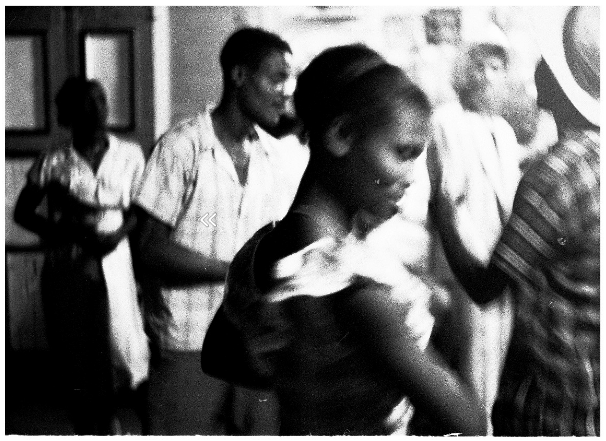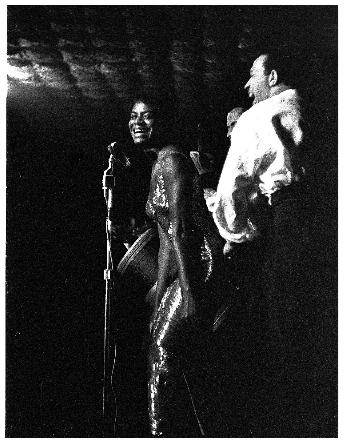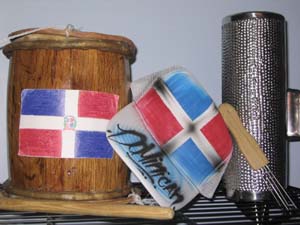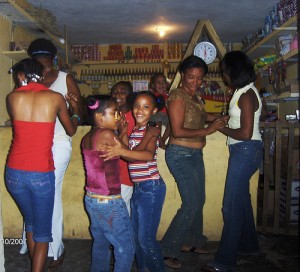One thing about Dominicans that endears me is their innate musical nature. They have an almost involuntary response to music — they simply must dance. But the musical culture is not contained merely within the Dominican Republic, it is indicative of the island as a whole, the island of Hispaniola, in which both the Dominican Republic and Haiti call their home. In fact one could question which culture is more musical, Haitian or Dominican, much like one would wonder which came first, the chicken or the egg.
I love to dance too, always have, and I owe my first dance edification to this same island of Hispaniola. At the age of 9 during one of my visits in Haiti with my father, I learned to dance Merengue. I was in a big dance hall with my father and his friends. We were sitting up on the second floor balcony looking down upon a large dance floor below where many couples danced away. I remember the big skirts of the girls in many colors as they swayed to the music which was up tempo. The men wore straight slacks and short sleeve dress shirts. Some had white hats with a band. The music never stopped and the dancers never stopped dancing.
We had been at the club for hours. It was late. My father and his friends had been drinking, smoking, and ogling the girls. There were no other kids there. I was bored and all the fun was happening down below. I had never danced before but the temptation was irresistible and I’ve never been good at resisting temptation.
The adults weren’t paying any attention to me so I slipped downstairs by myself and onto the dance floor. I had a pretty pink dress with yellow flowers, gathered in the bust with a full skirt and spaghetti straps. I went out to dance, by myself, the only kid on the dance floor, and after watching the couples for a while, taught myself to dance Merengue, or at least a close proximity. No one paid me any mind. They let me go and I had a blast.
For hours it seemed I danced. Back then I had a significant limp when I walked, one leg was nearly 5 inches shorter than the other, but on the dance floor it felt like I flew, I was hooked.
Ever since then I have loved to dance and Merengue, a musical style popular in both Haiti and the Dominican Republic, was a sentimental favorite. So it is no wonder that years later in my adulthood, when visiting the Dominican Republic, that hearing Merengue triggered a visceral response, ending in me moving there.
Back in Santo Domingo after nearly 8 months, the music is a soundtrack to my trip, always on, always a part of life. But what I love the most is how the music moves its listeners into dance, no matter when, where or what they are doing.

I love the dresses
The music: Merengue, Bachata, Salsa, Reggaeton or even just a couple of instruments played on the corner, all have same effect — the feet move in a slight shuffle, the hips sway and the hands tap.
When we were at the resort for our mini honeymoon, they had a local band, traditional style from the campo (country) which played music. One waiter was particularly moved by the music and was unable to contain himself. He cleared the tables with a sway in his hips, sometimes adding a spin. He clapped his hands when they were empty and enthusiastic hoots burst out, all the while with a broad smile on his face. He was a middle aged man with a classic face of someone who works hard and enjoys the simple things in life. Music was one of them.
By contrast, our “cobrador” on the bus (the man who collects the money) looked about 19. He had the style popular with the urban hip hop crowd in the States — baggy jeans, backwards baseball cap — but when the driver put Salsa on, he slapped his hands against the side of the bus, shuffled his feet and sang along, just like the waiter. Different walks of life sharing and almost reflexive response to music.
There are a lot of things that cause strife on this small island between the two cultures that call it home. Haitians and Dominicans are different in many ways but they share they love of music and the irrepressible urge to move to the beat. Music and dance happens spontaneously for short bursts and long stretches, in discos and street corners, in fancy dress and work clothes.
On this island which has so much poverty, corruption, inflation, and complication, music and dance are free to enjoy. By enjoying and even indulging in music, Dominicans and Haitians keep their spirits up as they move through their day. I love that. We Americans love our quiet, our silence and our space. There is none of that there. One is thrust into the rhythm and the best thing is to relax and let the music flow through you.

Dancing in the Street Avenida Venezuela, photo from www.dr1guide.com






ahh..avenida venezuela 🙂